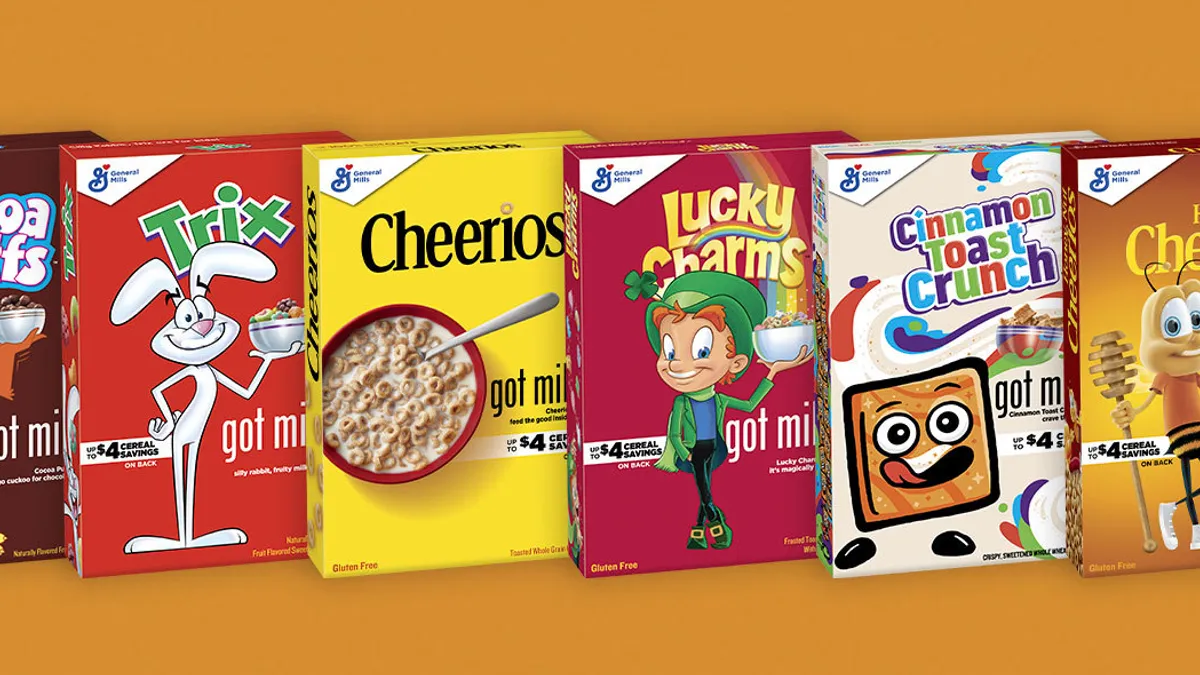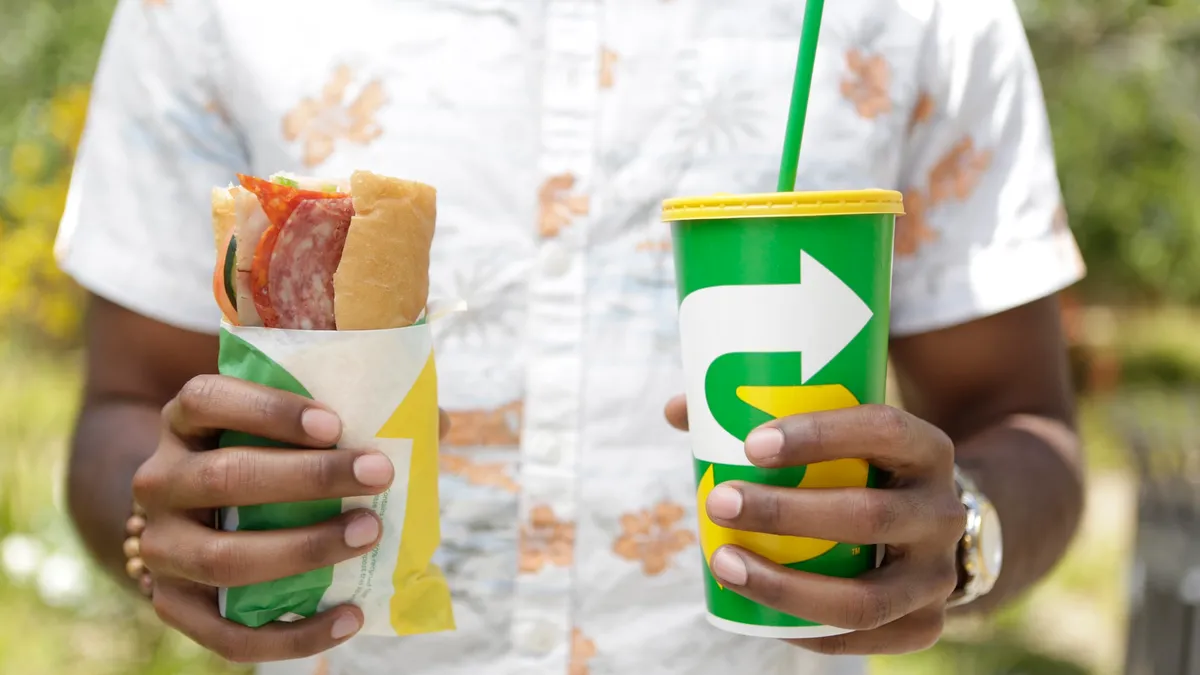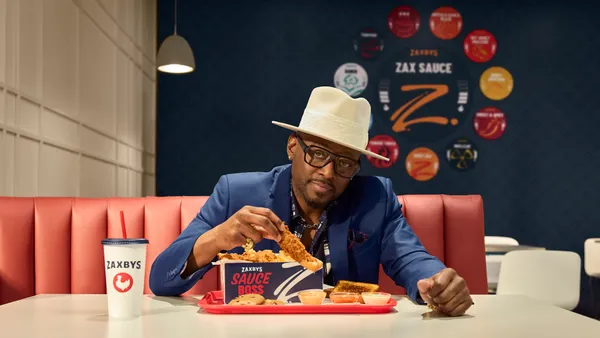General Mills stands among the packaged foods companies that have seen business turn around with the coronavirus pandemic, as a spike in home cooking and pantry-loading reignites sales. With people growing accustomed to the quarantine lifestyle nearly a year into the crisis, marketing is playing an important role in sustaining the windfall, with General Mills increasing its media investments — particularly in digital — while enacting a broader project of reimagining brands like Wheaties or its Boxtops for Education program, which made a more concentrated push on mobile last year.
"One of the things the pandemic's done is put marketing more squarely back in the middle of a company's operations," Ivan Pollard, chief marketing officer at General Mills, told Marketing Dive in a recent interview. "All of this stuff about not needing a CMO or marketing anymore, I think it's shifted back."
General Mills in some ways steeled itself for this moment, even if COVID-19 was a largely unforeseen disruption. Last February, when the virus' impact was most apparent in China, the company devised an Accelerate strategy to reinvent its business, a plan which it detailed further during a presentation at the virtual Consumer Analyst Group of New York (CAGNY) conference last week. Accelerate contains four directives that affect marketing: to boldly build brands, relentlessly innovate, unleash scale and be a force for good at the community and global levels.
Marketing Dive below spoke to Pollard, who joined the packaged foods giant from Coke in 2017, about what each of those aspects means and how his outlook on areas like agencies, data and purpose has evolved following an unprecedented year.
This interview has been edited for clarity and brevity
MARKETING DIVE: With the U.S. coming up on a year in lockdown, what's the biggest change in your thinking as a marketer now versus a year ago, and how does that factor into Accelerate?
IVAN POLLARD: We actually were working on the Accelerate strategy before we identified the virus. We launched it to the company in February of 2020. A lot of people were talking early on about the disruption [COVID] was causing, and then some of us started talking about it not actually being a disruption, it's an acceleration. It's accelerating the things that were coming anyway.
We knew e-commerce was going to get bigger, we knew that people were going to start to look at the way they were living and how they were living and challenge it at some stage. The biggest shift for us was proving to ourselves that we had the agility that was required during that time. We've gotten much faster, we've gotten a lot more agile and we've gotten better at future-focus. I think those things will stick.
Some of those consumer behaviors ... the joy of not commuting and eating breakfast or the joy of cooking and baking. Some of those things we are doing will help slow the half-life [of these trends] down. Pressures will come again from outside, but some of the behaviors that serve our business will endure, we believe.
One of Accelerate's four points is developing bolder brands. That's come into play with the pandemic and then again with the push for social justice that swelled last summer. How has your outlook on purpose evolved?
POLLARD: It's an acceleration, again. We were tracking what the younger consumers were saying, especially. But it's not that different, actually, for older consumers. There are expectations that consumers have about the way a company behaves to its employees, to the environment and, of course, to its supply chain. Those expectations do affect what people will buy.
We were already working toward how we were going to step up and step into the social justice issue, internally and externally. Obviously with the killing of George Floyd in our hometown, we had to do things. We've also been working for a long time reporting on our sustainable actions.
Is there any tension between keeping up a pandemic sales windfall and also setting a bigger project of imbuing brands with purpose?
POLLARD: When we boldly build brands with purpose, that actually is good business. Look at Unilever's sustainable brands: They account for 70-odd percent of their growth and they're growing faster. When everything else is equal, I'm not going to pay for a sustainable brand that tastes horrible, but I will pay for the same-tasting sustainable brand if somebody else is not sustainable.
We're going to have a fourth quarter that we must lap [in sales], but I don't think that's going to erode our sense of building brands with purpose. I think that's a critical part of the toolkit. The second question implicit in that is, "Will you dial back how much you're spending in order to help the finances there?" We could've done that at almost any stage during the pandemic, but as soon as it came out, we were like: Let's build the brands, let's do some good and let's stay away from profiting off the situation. But let's keep advertising as well.
I'm glad you touched on media investments. General Mills did a 15% hike for fiscal 2020. Are you planning to continue to stay in line with that trend?
POLLARD: We do still use the language "media investment," but what we're meaning is consumer engagement investment. So some of the investment is not in that 15% number. We're thinking about holistic connected investment, which means we've got to think about what we're going to spend on packaging or search engine optimization just in the same way we're thinking about what we spend on pre-roll or YouTube's new 15-second short content.
The whole of CPG went through years of declining investment in consumers, and we're starting to return to reinvesting in them as we're getting smarter about how to use the digital ecosystem. We're also getting much smarter about connecting the physical and digital worlds. When you connect those together, you can drive deeper understanding of the consumer and their problems.
The promise of digital a few years ago was it was going to decimate the costs we have to spend because we'd be much more targeted. What everybody's learned is, no, [digital] is a tool in your toolbox. It's not the best tool for every single job. We're still looking at investment in general going up in line with sales, and the way we shape that investment will be a function of who you're after and where they are.
You shared a chart at CAGNY that shows a bigger portion of overall investments going to digital and less to traditional TV in 2021. How do you gauge what's good in digital for General Mills in the long run versus being more of a short-term play?
POLLARD: There's an underlying shift. As the consumer is going there, we will go there, too. It depends on what job you've got to do. If you want to sell heart health to older people on a Sunday afternoon when the Super Bowl's on and do Cheerios, that's going to lead you to one solution: You go on TV. If all you do is go on TV, even for old people, you're not going to maximize the possibility. If you want to market Totinos to gamers on any other Sunday of the year, you probably don't want to be on TV.
And as people go out and about, we must never forget, despite the growth of e-commerce for grocery, a brilliant amount of our stuff is still sold through physical places. How do you join the physical experience of seeing something sitting on a shelf in a Kroger with the digital experience of seeing something on YouTube from General Mills? How do those two things work and how does that help us reach more people for less money?
You touched on e-commerce, which General Mills is signficantly ramping up. What does the linking of the physical and digital worlds look like in practice?
Pollard: We're not just going to keep straight lining up [on e-commerce]. When you can shop, there is a group of people who will shop because they like shopping.
Having said that, we're seeing one of the big consumer trends is this need for ease. A lot of that for e-commerce was about on-demand [with] Uber Eats, GoPuff, whatever it may be. What we saw in the pandemic was also an on-hand [trend] as well. What's in my pantry? What's in my freezer? Look at what's going on in Texas right now. Having it in your fridge is sometimes a good thing.
The e-commerce side of it is definitely going to grow; we're investing ahead there to learn. It's very difficult to get to first-party level data. We're getting receipt-level data that does good for the consumer. It's useful for us and as long as we're absolutely focused on privacy in that data, we can spot patterns in it and then we can start to experiment with how we do it. That's connecting the physical to the digital. You can do it the other way around as well.
We would've bought some pre-roll on YouTube or a post on Instagram or even our owned media five years ago without turning it into an instantly shoppable moment. Now, much more of our stuff has a click-to-buy [function] and we brought the infrastructure that sends you to the right place so you'd want to buy it, whether it's Instacart or it's Walmart.com or Amazon. A lot more of that will go on. That's what I mean by connecting the physical and the digital.
Retail media networks create an interesting dynamic with CPGs. Even amid the pandemic, the data question continues to be the big thing guiding a lot of decisions. How are you thinking through your internal teams and external partnerships when it comes to that stuff?
POLLARD: It's the speed, the scale and the granularity of [data] that's changed in the past 10 years, along with the tools that we've got in order to be able to leverage it. It might be brilliant understanding everybody's individual name, but I don't know if Coke can put everybody's individual name on a bottle. They'll pick 1,500 of the most common ones and localize them.
Internally, we've gotten a lot more focused on the power of data to predict. We're taking our insights teams now and [making them] as much intelligence teams as they are insight. They're helping us predict what we think might happen with a reduced degree of uncertainty.
The partnerships, our media agencies have obviously been very powerful on that. Let's not ignore what the [Association of National Advertisers] and ISBA keep finding out about the supply chain there. We're very focused on where our money is going. But it's really important to get the back channels for what's working and what's not, and the speed with which we can do that is helping our innovation pipeline. The media agencies are on it.
Increasingly, we're starting to think about our first-party data. We're pretty big on that because of Bettycrocker.com and Pillsbury.com and our partnerships with Pinterest and some of the other providers, but also with Amazon and with Walmart.
We're going to automate all of the stuff that told us what happened, we're going to start really beefing up the artificial intelligence that talks about why it happened and then we're going to get much better about what we are going to do to make what happens next be to our advantage.
At CAGNY, you mentioned Häagen-Dazs as a brand that's gone through a creative transformation through an agency switch. Coke is also in the middle of a comprehensive agency review. Are you thinking of similar things?
Pollard: Häagen-Dazs was doing well. The team felt it could do even better. The business is a little more French and a little more Chinese than people expect. They went with an agency called Forsman & Bodenfors that's headquartered out of Sweden and has a very good office in Shanghai.
I know what Coke's doing because it's what the CMO did when I was there. Marcos de Quinto did exactly the same thing. I was talking to an ex-agency colleague who's gone through that pitch just last week and he said, "It's déjà vu."
I think that's good. You should be thinking [that way]. What I talked about with data, with connected commerce, with us starting to think about cultural capital and purpose, we still need to put as much creativity into that as we do into our product innovation. Other people can use data to get you a breakfast offering; when we show up at your door, I want you to go, "that's brilliant." Creativity is still massively important to us.
Unless we see the opportunity to upskill, we're not holding huge agency reviews, but we are constantly reviewing the agencies. I think the days where the agencies had an agency of record model — an "until I fail" kind of model — are gone. There's some brilliant stuff happening, there's lots of space to explore and there's always new territory that agencies could take us into. So long as we hold onto what our brands stand for and don't outsource that to the agencies to steward, it gives us a bit more agility to find good ideas wherever they come from.























